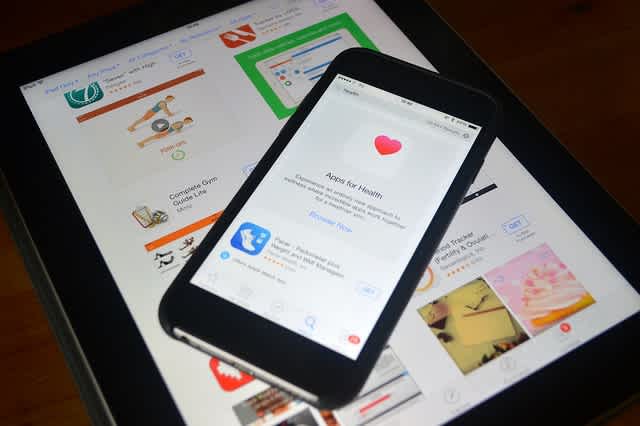Health apps have been one of the most sought-after categories on app stores for the past few years. In this time‚ apps have evolved from basic step-tracking systems‚ to become sophisticated ecosystems that interact with various features available on users’ devices and wearables. Major companies like Apple‚ Google and Microsoft have also invested in creating holistic ecosystems‚ with the aim of bringing all the user’s health data into one single location. While this concept sounds appealing‚ so far the results are not living up to expectations. These apps have become silos of raw data‚ most of which doesn’t make sense to the majority of users. Knowing the number of steps you’ve taken each day is irrelevant if you cannot equate this to the effect on your current and future health.
Another new feature that is appearing in most flagship devices and wearables is the ability to track heart rate. Whilst this has significant potential for development‚ currently it offers little more than an entertainment feature that users can show off to friends whose devices do not support this system (with few exception use cases like saving this teens life). There is no way of analysing the data‚ or providing information to users regarding their health in simple‚ easy to understand terms.
Lack of Information
![[object Object] [object Object]](http://images.ctfassets.net/o6514hijae09/4Dns9Sj2x3kNbkRIXr1xbL/6b18b6496f8801509514b6b3b9e06da4/15952621738_8072010af3_z.jpg)
Source: Flickr
Most users don’t need to know how many steps have they taken that day‚ or how many flights of stairs they have climbed over the week. However‚ what they do want to know is whether or not their health has improved each month. Mobile app developers and businesses need to concentrate on taking raw data and turning it into helpful information‚ so users can easily monitor their health‚ and track their progress when striving to improve their condition. When a user’s health deteriorates‚ they could also be warned of possible medical conditions they might have‚ or that could emerge in the future.
One of the main reasons why this is not happening right now is because of a lack of features that track anything more than basic measurables such as walking‚ running‚ climbing stairs and heart rate. This may encourage users to keep fit‚ but such small amounts of data provide little to no use for anyone concerned about monitoring their health or medical condition.
Of course‚ users can manually enter data points into dedicated apps and technology‚ to keep track of other conditions. However‚ with no automatic tracking available as of yet‚ it would make little sense for health-conscious users to invest in these devices. Besides‚ the data again would simply present a bunch of numbers with no useful insights into their health.
Harnessing Data for Good
![[object Object] [object Object]](http://images.ctfassets.net/o6514hijae09/76UOyG0dAFmO7kM0xhIgAc/c1ee37da8c5f248de4f670ea502b5686/8030637855_8be14978b2_z.jpg)
Source: Flickr
So‚ with no means of interpreting the data‚ all this information is simply stored in silos within users’ devices‚ going to waste. In an age where we realise the importance of data‚ we need to understand that this amount of information could be used not only for identifying patterns in medical conditions‚ but also to conduct research that will help us understand trends in a family‚ community‚ city or even country. We recently outlined how this vision might look in practice in our assistive healthcare research paper.
Apple is leading the way in addressing this issue. Over the coming years‚ ResearchKit is going to help researchers utilise the data provided by patients and users all over the world‚ to understand the patterns of ailments and find solutions to medical challenges.
However‚ this is just the start. ResearchKit is still in its infancy‚ and needs to improve significantly to reach its full potential. Currently‚ only a handful of ailments are being covered by apps and ResearchKit – there are thousands more that could benefit. However‚ the outlook is optimistic. One of the reasons why ResearchKit was accepted well by users was Apple’s guarantee regarding the security of information during its launch.
Users are understandably concerned about the security of sensitive information. For many years‚ this has limited progress in health apps; users want peace of mind about the security and confidentiality of data that is collected from their apps. This poses a challenge‚ as security measures lock valuable data in silos‚ preventing users from receiving beneficial insights. However‚ when overcoming this problem‚ it’s essential to keep a degree of security in place‚ to prevent the misuse of this information.
The Future of Health Data
![[object Object] [object Object]](http://images.ctfassets.net/o6514hijae09/JZzHjbwEDhJvV7nnqR8U7/04026145d91397b46da251d5ab86c2fd/7699595932_def1aba564_z.jpg)
Source: Flickr
To strike a balance between patient confidentiality and accessible information about users’ health‚ the next generation of health apps must be able to collect raw data on not just basic activities‚ but other health-related information too. They must also find a way to securely transfer this data for analysis‚ both for users and the healthcare professionals that treat them. If‚ on top of these features‚ apps were able to provide warnings about possible ailments with actionable solutions‚ smartphones and wearables would find a new role in promoting healthier lifestyles around the world.
These apps will not completely remove physicians from the equation‚ but will provide a better understanding of any possible ailments to users‚ making it easier to diagnose and treat health conditions.





